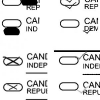Free Online Productivity Tools
i2Speak
i2Symbol
i2OCR
iTex2Img
iWeb2Print
iWeb2Shot
i2Type
iPdf2Split
iPdf2Merge
i2Bopomofo
i2Arabic
i2Style
i2Image
i2PDF
iLatex2Rtf
Sci2ools
88
Voted
ICPR
2008
IEEE
2008
IEEE
Ballot mark detection
Optical mark sensing, i.e., detecting whether a "bubble" has been filled in, may seem straightforward. However, on US election ballots the shape, intensity, size and position of the marks, while specified, are highly variable due to a diverse electorate. The ballots may be produced and scanned by poorly maintained equipment. Yet near-perfect results are required. To improve the current technology, which has been subject to criticism, components of a process for identifying marks on an optical sense ballot are evaluated. When marked synthetic ballots are compared to an unmarked ballot, the absolute difference of adaptive thresholded images gives best detection rates for all darknesses of marks, but at a false alarm rate increase. Simple absolute differencing can give good detection results with lower false alarm rates.
Related Content
| Added | 05 Nov 2009 |
| Updated | 06 Nov 2009 |
| Type | Conference |
| Year | 2008 |
| Where | ICPR |
| Authors | Daniel P. Lopresti, Elisa H. Barney Smith, George Nagy |
Comments (0)

